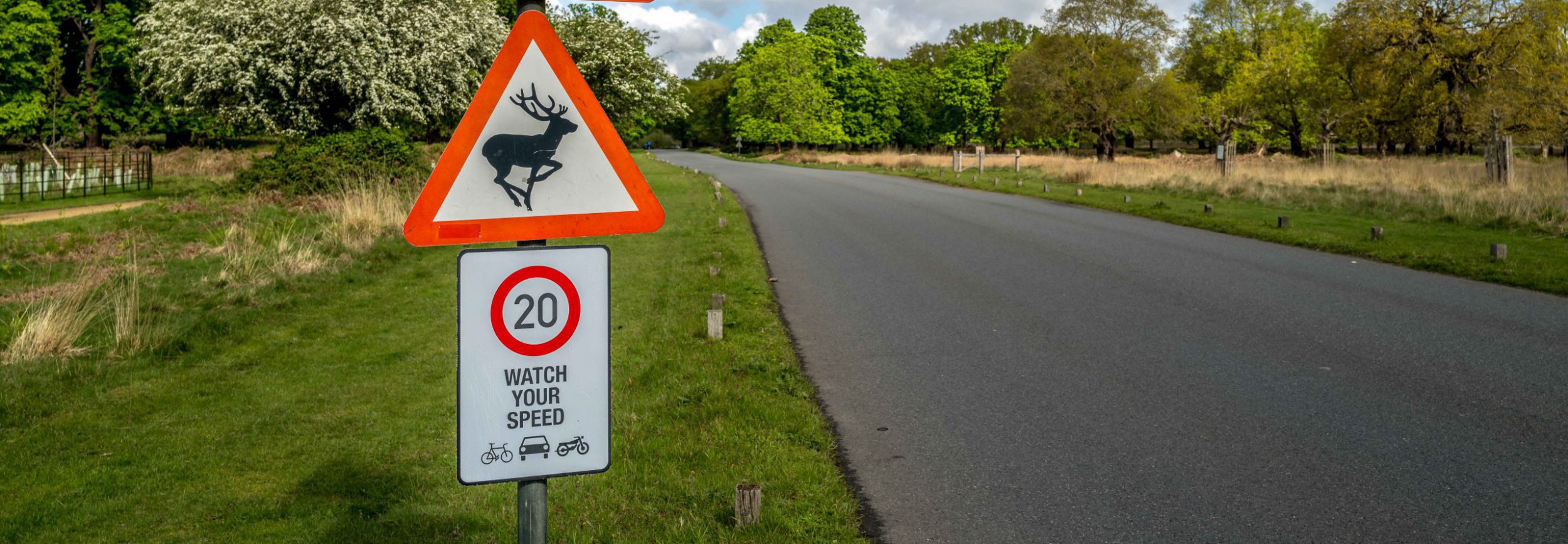Understanding road signs is essential for the safety of all road users, and especially important when you’re learning how to drive. While many signs are familiar, some are less common but equally important. Explore the various types of road signs and take a look at some uncommon ones you might encounter on UK roads in this blog.
What different types of road signs are there?
Road signs are vital for conveying information, instructions, and warnings to drivers. They play a crucial role in ensuring the smooth flow of traffic and the safety of motorists, cyclists, and pedestrians. In the UK, road signs come in various shapes and colours, each signifying different types of messages. There are three basic types of traffic sign, each with a different shape – circle, rectangle and triangle.
Circular road signs
Circular road signs are known as regulatory road signs, and commonly give orders that must be followed. These signs often indicate regulations such as speed limits, traffic directions and other necessary actions. There are two different colours of circular road signs, each used depending on the type of instruction.
Blue circular road signs generally give a positive instruction, such as ‘turn left’, or indicate if a road is only available to a particular vehicle, e.g. buses or bicycles only.
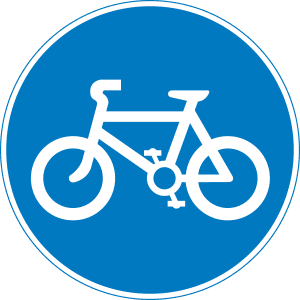
Route for use by pedal cycles only*
Red circular road signs generally give prohibitive instructions, telling road users what they must not do. They are either entirely red, have a red ring around the edge or have a red ring around the edge with a diagonal red line through the middle. One of the most common uses for this type of sign is to inform drivers of the speed limit on a road.

Maximum speed limit of 30 mph*
Rectangular road signs
Rectangular road signs are used to inform drivers and give them information. These signs are typically used to inform about directions, distances and specific conditions on the road. There are different colours of rectangular road signs, with the different options used depending on the type of road you’re on and the type of information they’re giving.
Blue rectangular road signs have two uses, depending on where they are situated.
- On motorways, blue rectangular road signs give directions to upcoming destinations.
 *
*
- On all other roads, blue rectangular road signs give general information, often about the type of road access or priorities.
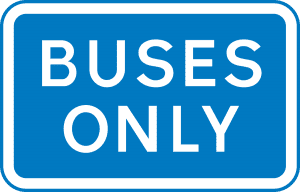 *
*
Green rectangular road signs are used to give directions on roads that are primary routes, like A roads. On these signs, directions mentioning motorways will be highlighted with a blue panel and directions to non-primary routes are in white.
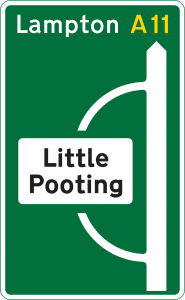 *
*
White rectangular road signs are used to give directions on roads that are non-primary routes. They all have black borders and generally use black writing and symbols.
There are three main types of white rectangular road signs:
- Directions on non-primary or local routes: as well as general locations on minor roads, these signs are also used to show parking areas.

Multi-storey parking 250 yards*
- In conjunction with other signs to give more information: used for warnings or regulations, they often appear along with a circular or triangular sign.
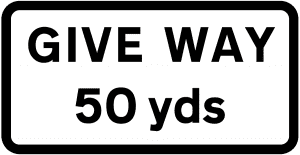 *
*
- Providing more information: where any additional information is needed, these signs usually contain text and appear along with a circular or triangular sign.
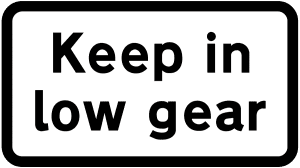 *
*
Brown rectangular road signs are used for tourist information, directing road users to popular attractions or facilities from main (A) roads or motorways. They often direct to places like zoos, museums, campsites or hotels, featuring relevant text and an icon to represent the destination.
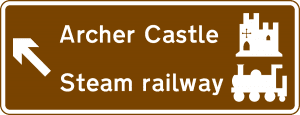 *
*
Triangular road signs
Triangular road signs are used to warn drivers of potential hazards ahead. These signs usually have a red border and white background. They alert drivers to be cautious and prepared for conditions such as sharp bends, traffic signals, junctions and other types of potential hazards. They can often be seen along with a white rectangle sign providing extra information about the hazard.
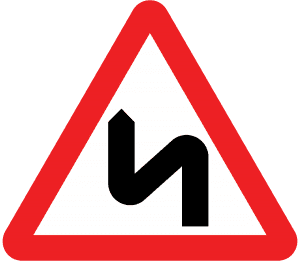
Double bend or series of bends ahead, first to the left*
What are some of the most uncommon road signs in the UK?
In addition to the more common road signs, there are a number of uncommon road signs that drivers might encounter. Despite not seeing these signs as often, drivers should still be aware of what they mean.
Migratory Toads Crossing Road Sign
This road sign is used to indicate areas where toads are known to migrate across the road. The migratory toad crossing road sign is used only at approved sites and is only visible during times of toad migration, particularly during breeding season, to ensure that road users take the warning seriously. Drivers should slow down and watch for toads crossing the road to avoid harming them.
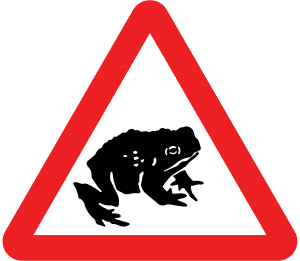
Migratory toad crossing ahead*
Slow-Moving Military Vehicles Road Sign
The slow-moving military vehicles road sign is used to warn drivers to be prepared to experience slow-moving military vehicles. It is typically found near military bases or training areas, or locations where military vehicles are expected either to cross the road ahead or to be moving at low speeds along the road. When seeing these signs, drivers should be ready to slow down and give way to these vehicles.

Slow moving military vehicles likely to be crossing or in the road*
Quayside or Riverbank Road Sign
This road sign is a warning sign for road users that may be approaching the end of the road where a river or quay edge may not be visible. It is used to indicate proximity to a quayside or riverbank where there is a risk of vehicles accidentally driving into the water. Drivers should proceed with caution when seeing these signs and be aware of the potential dangers.
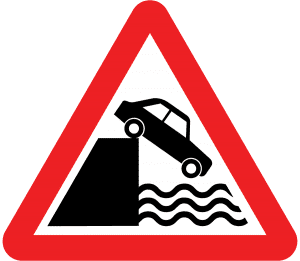
Quayside or river bank ahead*
No Horse-Drawn Vehicles Road Sign
The no-horse drawn vehicles road sign is used to indicate a route protected by a byelaw to stop horse drawn carriages along a section of road. It is also used to protect a route that is only intended for pedestrian and bicycles. The sign indicates that horse-drawn vehicles are not allowed on the road. It is typically found in urban areas where horse-drawn traffic might disrupt motor traffic.

Horse-drawn vehicles prohibited*
Designated Quiet Lane Road Sign
This sign marks the entry and exit point of a road that has been designated as a Quiet Lane. Quiet Lanes are roads that can be used by non-motorised traffic for activities such as cycling, horse-riding, jogging and walking. Motor vehicles should avoid these lanes or roads or proceed along them with extreme caution.
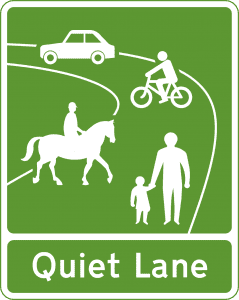
Start of a designated quiet lane in England*
No Vehicles Carrying Explosives Road Sign
The no vehicles carrying explosives road sign is a regulatory sign that prohibits vehicles carrying explosives from using a road. It is usually found at the entrance of densely populated areas or long tunnels where the vehicles can then be advised of another route or be escorted through the tunnel.
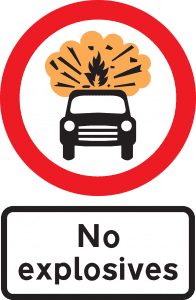
Vehicles carrying explosives prohibited*
Wild Horses or Ponies in Road Ahead Road Sign
This sign warns drivers of the potential presence of wild horses or ponies on the road ahead. It is often found in rural areas like national parks. When seeing this sign, drivers should slow down and be prepared to stop.
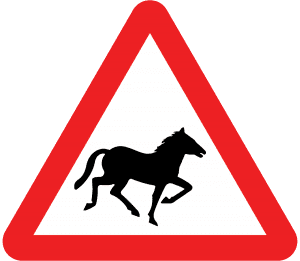
Wild horses or ponies likely to be in road ahead*
Wild Fowl Likely in Road Ahead Road Sign
The wild fowl likely in road ahead road sign lets drivers know that they may find ducks or other wild birds in or crossing the road. It is commonly seen near wetland or nature reserves. Drivers should be cautious when seeing this sign and be prepared to slow down or stop to avoid harming the wildlife.
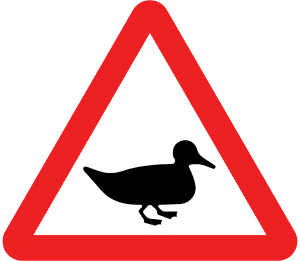
Wild fowl likely to be in road ahead*
Ford Road Sign
This road sign indicates that there is a shallow water crossing ahead, where the road crosses a stream or river. The sign is located at a ford, which is a shallow place in a river that can be easily crossed by walking or driving. When seeing this sign, drivers should assess the water depth and flow before proceeding to make sure they can safely cross.
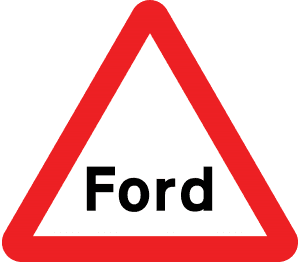
Ford warning*
Railway Level Crossing Without Barriers Road Sign
The railway crossing without a gate or barrier sign warns road users of a railway level crossing ahead that does not have barriers and highlights the potential hazard of a train crossing the road. This sign is most commonly found on roads and footpaths that cross railway lines and is sometimes accompanied by an audible alarm. When seeing this sign, drivers should approach with caution and stop, look and listen for trains before crossing the track.
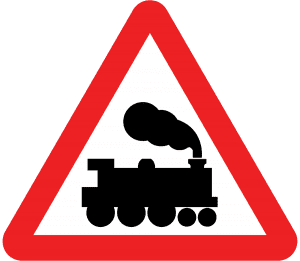
Railway level crossing without gate or barrier ahead*
Low-Flying Aircraft or Aircraft Noise Road Sign
This sign alerts drivers to areas where low-flying aircraft, such as commercial jets or gliders, may be present, or where there might be significant aircraft noise. It is often found on roads around the vicinity of airports and airfields. Drivers should proceed with caution when seeing this sign as road users can be easily caught off guard by aircrafts’ sudden appearance or noise.
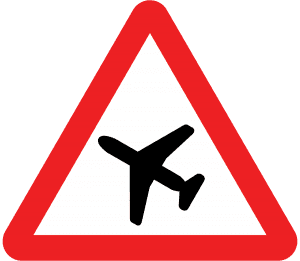
Low flying aircraft or sudden aircraft noise likely ahead*
Falling Debris or Rocks Road Sign
The falling debris or rocks road sign is used to warn drivers of areas prone to falling debris or rocks. There are variants of this sign that indicate whether the falling debris or rocks may fall from the right or left side. Typically, these signs can be found in mountainous or cliffside regions. When seeing these signs, drivers should be vigilant of their surroundings and be prepared for sudden obstacles in the road.
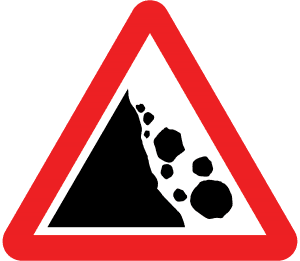
Risk of falling or fallen rocks ahead*
Cattle Crossing Road Sign
This sign indicates areas where cattle may cross or walk along the road. It warns drivers of the potential hazard of cattle crossing a public highway. It is often found in rural or farming areas. When seeing this sign, drivers should slow down and watch for animals along the road.

Cattle likely to be in road ahead*
Why is it so important to follow road signs in the UK?
Following road signs is crucial for maintaining safety on the roads. Road signs guide drivers, provide warnings, and inform them about road conditions. Following the instructions or being aware of their warnings ensures the safety of drivers, passengers, pedestrians, and wildlife.
It is also a legal requirement to obey certain road signs to avoid accidents and legal consequences. All circular road signs are mandatory, meaning their orders must be followed.
What sort of punishment could you receive for ignoring road signs in the UK?
Ignoring road signs can result in severe punishments, including fines, points on your driving license, or even driving bans. The severity of the punishment depends on the nature of the violation and its potential impact on road safety.
For example, if you are caught disobeying a circular road sign, you risk a fine, points on your licence, or a driving awareness course.
Will I be tested on different types of road signs when learning to drive?
Yes, identifying and understanding different road signs is a key part of learning to drive. During the practical driving test, examiners assess how well you navigate roads using road signs and how you respond to various road signs. Additionally, your knowledge of road signs will be tested during the driving theory exam, ensuring you are well-prepared to drive safely on the roads.
Get learner car insurance with Dayinsure
Learning to drive involves understanding and responding to a wide variety of road signs. The best way to experience different types of road signs is to get out on the road practising your driving.
With Dayinsure, you can get fully comprehensive temporary learner driver insurance, ensuring you are protected whilst you gain valuable driving experience. Enjoy peace of mind whilst focusing on mastering the road with Dayinsure.
Our learner insurance is flexible, with cover available from 1 day up to 5 months. Find out more about our learner driver insurance here and get a quote today.
*© All road sign graphics shown are crown copyright (Open Government Licence)
